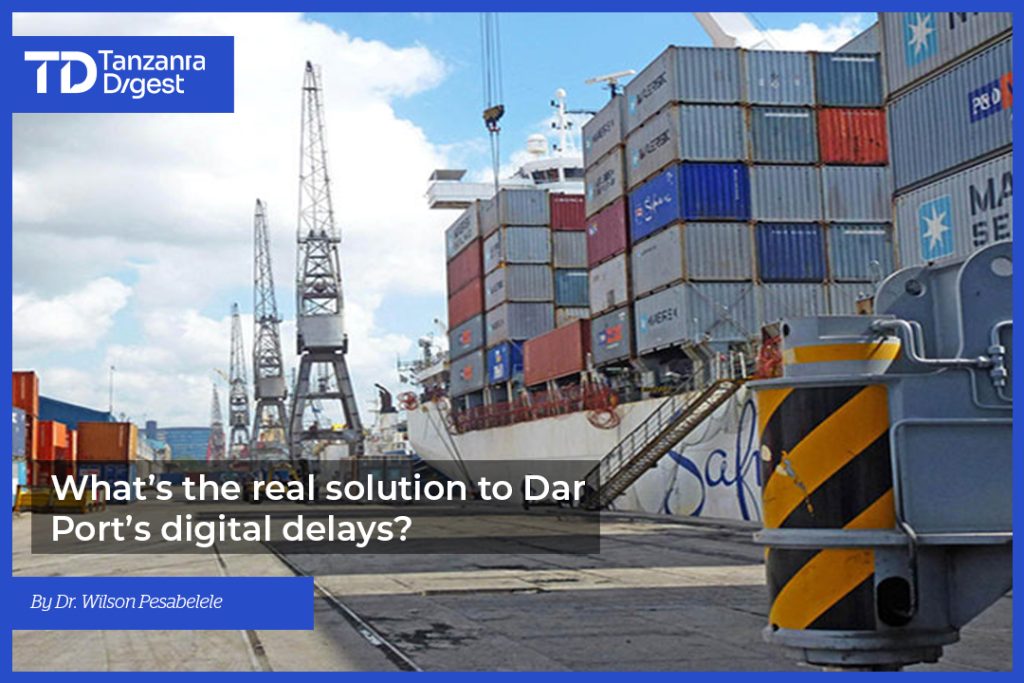When Digital Isn’t Fast
In theory, Tanzania’s port systems are fully digitized. In practice, traders still walk between desks with printed documents, chasing signatures in corridors meant to be replaced by code. The Tanzania Customs Integrated System (TANCIS), the Port Community System (PCS), and the Tanzania Electronic Single Window (TeSWS) were all introduced to modernize the movement of cargo. Billions have been spent. Dashboards light up. Yet the files don’t move.
This paradox, high investment, low fluidity, reveals the core of Tanzania’s logistics bottleneck today. At Dar es Salaam Port, digital infrastructure is robust. But the underlying systems remain siloed, unaligned, and riddled with human workarounds. The result? Cargo sits. Trust erodes. And the port’s regional ambitions face invisible friction that no crane can lift.
Tanzania’s Port Digitization Drive: A Quick Recap
Between 2018 and 2025, Tanzania deployed an ambitious suite of logistics technology platforms. TANCIS became the national digital customs system, automating declarations, risk profiling, and clearance processes. The TeSWS promised integration with banks, regulatory bodies, and freight agents to reduce multi-agency duplications. The PCS aimed to become the single backbone linking port users, shipping lines, transporters, TRA, and TPA into one data ecosystem.
Most recently, in January 2025, a major TANCIS upgrade introduced new modules, smoother interfaces, and a revamp of internal routing protocols. Yet, despite these rollouts, traders and clearing agents continue to report extensive delays, many still tied to manual interventions, incomplete integration, and poor system interoperability.
Digitization, it turns out, is not the same as integration.
Ground‑Level Reality: Why Documents Still Delay
Despite having uploaded clearance documents online, many traders still find themselves printing hard copies to hand-deliver to various agencies. The customs officer cannot access what the port officer sees. The shipping line’s manifest does not sync in real time with TRA’s valuation records. Even basic steps, like uploading an exemption letter, can trigger a request to present the same letter physically at a desk.
Clearing agents operate like human routers, managing passwords across four or five different portals, guessing which system crashed today, and arbitrating disputes between timestamps. The systems may be digital, but the friction is analog. And the time lost is real: for low-risk containers, dwell times still hover between 8 and 12 days, well above the regional target of 5 days for competitive ports.
The data flows exist. But they are not talking to each other. And when machines don’t speak, people have to, at significant cost.
The Real Cost of Fragmentation
Systemic inefficiencies in port digitization don’t just cause delays, they bleed revenue, frustrate investment, and tarnish Tanzania’s logistics brand. According to stakeholders, Dar es Salaam’s port has lost out on preferred regional transit volumes, particularly for high-value, time-sensitive cargo like pharmaceuticals and electronics.
In May 2025, Rwanda’s Private Sector Federation noted improved turnaround at Dar. Still, it cited “persistent verification delays and unclear digital customs protocols” as reasons some traders continue to split shipments between Mombasa and Dar. Meanwhile, freight forwarders operating across the Central Corridor report spending upwards of 12–18 hours troubleshooting between PCS and TANCIS on a routine cargo clearance, an invisible cost that inflates trade friction.
The automation paradox is apparent: instead of speeding up operations, disjointed systems have replicated bureaucracy in a new digital form.
Models of Integration: What Kenya, Rwanda, and Ghana Got Right
Tanzania is not alone in facing the integration dilemma. But regional peers offer practical lessons.
In Kenya, the Kentrade Single Window System connects customs, port, tax, and transport departments via a unified digital interface. Most importantly, it’s legally backed, meaning agencies must comply with real-time data-sharing protocols. Users log in once, submit once, and track everything in a central dashboard.
Rwanda’s Smart Customs platform links with Tanzania’s port via the Electronic Cargo Tracking System (ECTS), reducing theft and clearance errors. Even Ghana, often overshadowed in East Africa logistics debates, has demonstrated remarkable success with its paperless ports strategy, streamlining all regulatory clearance into a centralized platform operated by a public–private partnership.
The common thread? These systems don’t just exist, they interoperate. And their design reflects user needs, not institutional turf battles.
Fixing the Disconnect: Three Practical Reforms
If Tanzania is serious about becoming a regional logistics hub, it must prioritize systemic integration over superficial upgrades. Based on both user feedback and regional benchmarks, three interventions stand out:
- Unified Login Architecture
Eliminate system fragmentation by consolidating TRA, TPA, and PCS under a single secure login with role-based access, no more juggling passwords or re-uploading files. - API-Driven Data Exchange
Mandate all logistics and trade-related agencies to operate on a standard data-sharing API, allowing real-time document verification, automated tracking, and synchronized cargo clearance. - Accountability Dashboards
Introduce publicly visible dashboards that track where and why delays occur, by agency, process step, or system, creating a transparent performance culture.
Without such measures, every TANCIS upgrade will be another coat of paint on a shaky foundation. Integration isn’t just technical, it’s institutional. And political.
Integration Is the New Infrastructure
Tanzania has made commendable progress in digitizing its trade environment. But if we’ve learned anything from Dar es Salaam Port’s journey, it’s this: infrastructure without integration is an illusion. The cranes may be new, the tracks may shine, and the systems may buzz, but if they don’t speak to each other, the economy stands still.
This is no longer a matter of convenience. It is a matter of competitiveness. In today’s regional logistics race, time is currency, and Tanzania cannot afford to keep losing it at the login screen.
The real bottleneck is no longer physical, it’s institutional. And that’s why Tanzania’s next port reform must start not with another IT tender, but with a complex political decision: to unify systems, enforce interoperability, and hold every actor in the chain accountable for the time they steal from trade.
Until then, we will remain a country of digital systems and handwritten delays.
🔗 Missed Day 5? Port Governance and Dar’s Future

